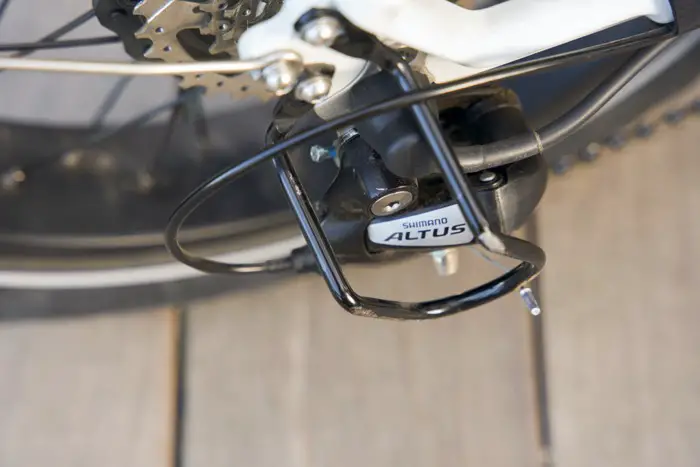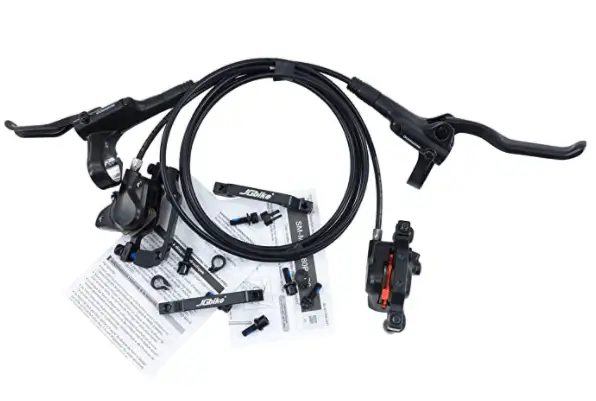Electric bicycles, or e-bikes, are growing in popularity. As more e-bikes become available, you may be wondering how they work, specifically the brake system, which is usually disc brakes. All bikes need brakes, and there are different brakes available, but are disc brakes necessary on your e-bikes?
Disc brakes aren’t necessary on your e-bikes, but a disc braking system is generally the best kind to use. They come in a variety of sizes and materials, are easy to maintain, and can be mechanical or hydraulic. There are alternative brakes, like rim and drum brakes, but they aren’t as good as disc brakes for e-bikes.
This article explains what disc brakes are, why disc brakes are good for e-bikes, and what types of disc brakes there are. I also explain the alternative braking systems for electric bikes and show you some videos to help you learn more about e-bike braking systems.

What Are Disc Brakes?
A disc brake comprises a disc, a brake pad, and a piston. The disc rotates in sync with the wheels on the bike, and it’s how the brakes got their name. A pad is on each side of the disc, which is flush with the disc and the piston.
The piston presses the pads against the disc when the rider hits the brakes. When the pads are pressed against the disc, it creates friction, which causes the e-bike to slow down or stop, depending on the amount of pressure. Bigger disc brakes have more friction, so they stop faster and with less pressure on the brakes compared to smaller ones.
Disc brakes are common in many moving things like pedal assist e-bikes, traditional bikes, and cars.
However, when you use your e-bike or other vehicles often, the brake pads will start to wear out over time, especially if you brake hard or often. Make sure you check your brakes and change the pads when they start to wear out.
The highly-rated JGbike Shimano MT200 Hydraulic Disc Brake Set (available on Amazon) are great disc brakes that you can use for e-bikes and other bikes. They are 160mm (6.29 inches) in size and come with pads, so all you need to do is install them on your electric bike and you are ready to ride.

Types of Disc Brakes for E-Bikes
There are two types of disc brakes you may find on an electric bike; mechanical and hydraulic.
Mechanical Disc Brakes
Mechanical disc brakes use a cable connected to the brake and the braking button or lever on your electric bike. When you hit the button to make the bike stop, the brake cable connects with the brake pad and makes them clamp against the disc, therefore, stopping your e-bike. This mechanical disc brake system is similar to how regular bikes brake.
You can adjust mechanical disc brakes to be closer or further away from the disc, which changes how fast or how slow your e-bike brakes are. When the pads are closer to the disc, your e-bike brakes easier, and you don’t have to hit the brake lever as hard to stop it. When they are further from the disc, you must press the brake lever harder to stop the bike.
Hydraulic Disc Brakes
The second type of disc brakes, hydraulic brakes, uses oil to brake the e-bike. A tube of oil in the brake system goes from the lever to the disc brake. When you brake your e-bike, the oil creates pressure against the brake pads. The more you press the brake lever, the more pressure there is in the brake system, making you stop faster. This is especially important in wet or icy cold weather.
You can’t adjust hydraulic disc brakes easily like mechanical brakes. They adjust how far the pad is from the disc automatically. So, if you are having a hard time braking on your e-bike and have hydraulic disc brakes, you’ll need to have a bike mechanic adjust them.

Choosing Disc Brakes for Your E-Bike
Disc brakes are the most common on electric bicycles, and there are good reasons for that. They offer some of the biggest benefits, particularly, in terms of reaction times.
Bigger Disc Brakes Are Better
Most disc brakes work great for e-bikes, yet different sizes affect how the disc brakes work. Ideally, bigger is better, especially on the front wheel where most of the braking is done. The front brake isn’t used as much as the back one, but it’s the most important brake when you need to stop quickly, like when in a high traffic area and a sudden stop is crucial.
Larger disc brakes also make it easier to stop your e-bike. When you have a large disc brake, you don’t have to press down on the brake lever as much as you would when you have smaller disc brakes. Less pressure means you stop easier when needed, which is great for sudden stops and less wear on your brake system.
Materials Affect Cost and Quality
Furthermore, disc brakes come in different materials. Some options include aluminum, plastic, and steel. The different materials change how much your brakes cost, how long they last, and how well they work for intense biking and in different weather. For example, steel brakes are best for braking when in rain or other wet conditions and for sudden stops.
You’ll also want to consider brake pads. Several factors can affect them such as the frequency of riding, road and weather conditions, and quality of the disc brake components among other things. Thus you may need to replace them frequently if you’re hard on them. You should consider this when buying disc brakes.
Fortunately, it’s inexpensive to buy new pads and you should always choose the best brake pads for your situation.
Mechanical Disc Brakes vs Hydraulic Disc Brakes
Although disc brakes are recommended as the best brakes for e-bikes, how do you choose between mechanical brakes and hydraulic brakes?
In general, hydraulic disc brakes have superior braking performance if you ride your e-bike fast, as they have better stopping control and braking power. They also tend to feel smoother when braking. However, you might choose mechanical disc brakes because they are less expensive and easier to repair, especially if you are not a fast rider.
This YouTube video from Trail Features explains when you should choose mechanical disc brakes over hydraulic ones and vice versa:
Alternatives to Disc Brakes for E-Bikes
Disc brakes are the most common for electric bikes that weigh much more than regular bikes, but you might come across other kinds. Two other types of e-bike brakes are drum brakes and rim brakes.
Drum Brakes for E-Bikes
This type of brake system is older than disc brake systems. There are two drums on each side of the wheel, and when the brake lever is hit, the drums press outward, creating friction and stopping the bike.
They stop much slower than disc brakes, and they need to be replaced when worn out, which costs more than tuning up disc brakes. These aren’t recommended for electric bikes.
Rim Brakes for E-Bikes
The second alternative type of e-bike brakes is rim brakes. When you brake a bike with rim brakes, the brakes stop the wheel on the rim of the e-bike tire instead of in the center like disc brakes. Brakes on the rims are not as sturdy as braking in the center.
Rim brakes don’t stop as fast as disc brakes, especially in rain or wet paths where the rim brake needs an extra second to stop. This is why they’re not typically recommended for heavy electric bikes. But there are some advantages to using rim brakes on an e-bike such as being lighter, less costly, and easier to repair and maintain.
This video on Youtube from GCN Tech explains how disc brakes compare to rim brakes:
Final Thoughts
It’s not necessary to have disc brakes on your electric bike, but you do need brakes, and disc brakes are the best ones to have. This is why most well-known e-bike brand manufacturers are building new electric bike models with disc brakes.
They’re easy to adjust, make braking easier, and perform better in wet weather, including rain and snow. Plus, they come in a variety of materials and sizes to suit any ride and rider. Although alternative brake options including rim brakes are available, they just aren’t as good as disc brakes when it comes to e-bikes.


